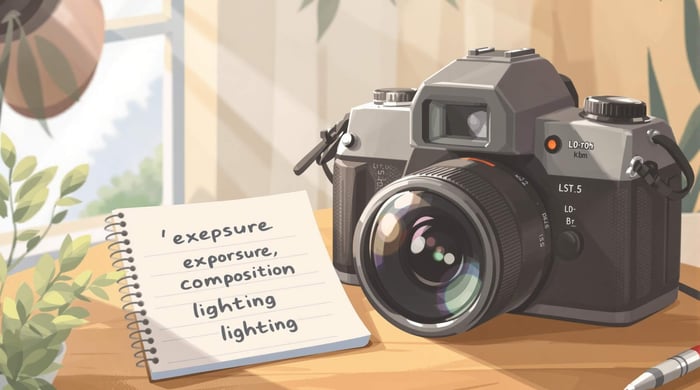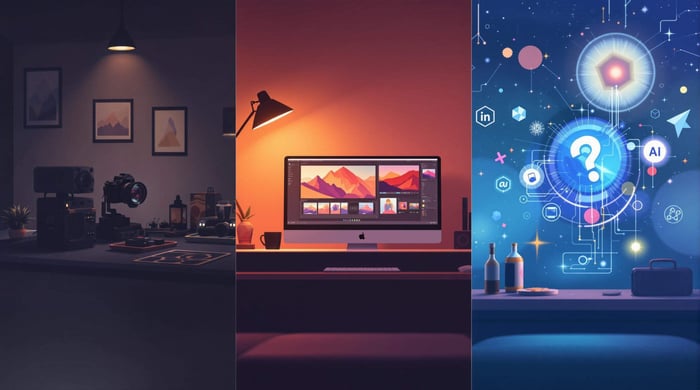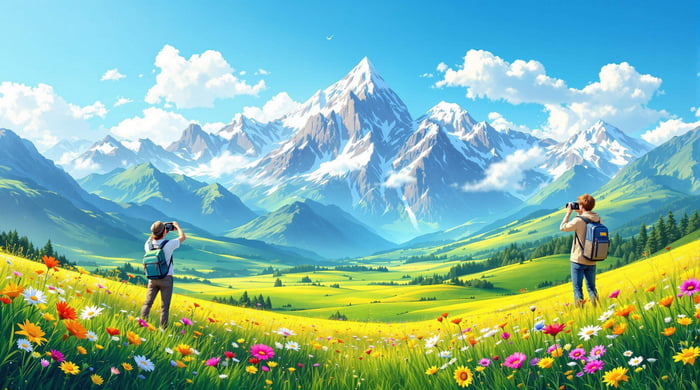Global Photography Trends: What’s Popular in 2024 and Beyond
Photography in 2024 blends classic styles with cutting-edge tech. Here’s what’s shaping the industry:
- AI in Photographic Arts: Automates tasks like noise reduction and background removal, freeing up time for creativity.
- Experimental Techniques: Double exposures, light painting, and forced perspective are making a comeback.
- Natural Aesthetics: Minimal editing, bold contrasts, and genuine storytelling lead the way.
- Immersive Formats: 360-degree Photographic Arts and drones offer new perspectives.
- Advanced Editing Tools: Lightroom presets, Luminar NEO, and Capture One dominate editing workflows.
Photographers are focusing on authenticity and innovation, combining timeless methods with modern tools to create engaging visuals. Whether you're a hobbyist or a pro, these trends can elevate your work while keeping it relevant.
Top Photography Trends for 2024
The Role of AI in Photography
AI is changing the game for photographers by automating tasks like background removal and noise reduction. These tools free up time, allowing photographers to focus on their creative vision instead of spending hours on technical fixes [1][2]. With these advancements, many are finding new ways to push visual storytelling to the next level.
Trending Techniques in Photography
In 2024, experimental techniques are seeing a resurgence. Methods like double exposures, light painting, and forced perspective are gaining traction, offering photographers fresh ways to tell stories through their images [1][3]. The Brenizer Method, known for its ability to create striking portraits with incredible depth of field, is also making waves [4].
These techniques reflect a broader trend toward bold and dramatic styles, as photographers continue to seek new ways to capture and convey emotion.
Shifting Photography Styles
This year, photography trends are all about authenticity. High-contrast images featuring bold shadows, vibrant colors, and vintage touches are taking the spotlight, adding a dramatic flair to visual storytelling [1].
Immersive formats like 360-degree photography are also gaining popularity, especially in real estate and landscapes, as people crave more engaging visuals [1]. Drone photography is evolving too, with improved technology making aerial shots easier and more dynamic, particularly in outdoor and adventure settings [1].
These shifts are influencing editing tools and workflows. Lightroom presets, for example, are helping creators combine technical precision with a more personal, expressive touch.
New AI Features in Lightroom: 2024 Photography Innovation

New Approaches to Photo Editing
As Photographic Arts trends shift, editing tools are evolving to keep up with the demand for both creative expression and streamlined workflows. In 2024, the focus is on tools that save time while still delivering stunning results.
Making the Most of Lightroom Presets
Modern Lightroom presets, such as those from Presets.io, are designed to cater to a variety of styles, helping photographers maintain consistency while speeding up their editing process. Here’s how to get the best out of them:
- Start with RAW files: RAW files give you more control when applying presets and fine-tuning edits.
- Customize to match your vision: Presets are a great starting point, but tweaking them ensures your photos stay true to your style. Batch processing similar images can also help maintain a cohesive look across your project.
Think of presets as a foundation. By making small adjustments, you can create a polished, professional result that reflects your unique aesthetic.
Advanced Editing Tools to Know
Photographers now have access to editing software tailored to specific needs, offering tools that range from quick fixes to precise adjustments. Two standout options are Luminar NEO and Capture One.
- Luminar NEO: Known for its AI-powered tools, this software simplifies creative edits, making it a favorite among portrait photographers.
- Capture One: With its professional-grade RAW processing and advanced color grading, it's a go-to for landscape and studio photographers. Its real-time tethering capabilities are especially useful for studio shoots.
Each platform has its strengths. Luminar NEO is perfect for those looking to experiment with creative effects, while Capture One is ideal for photographers who demand precision and high image quality.
To stay ahead in 2024, photographers need to balance cutting-edge tools with storytelling that feels real and engaging. Mastering these tools can help integrate emerging trends into your workflow without losing your unique perspective.
How to Apply Trends in Your Work
Incorporating Photographic Arts trends into your projects is all about finding the right balance between staying current and staying true to your personal style. Here's how to make trends work for you without losing your creative voice.
Steps to Use Trends in Projects
The first step is to identify trends that align with your goals and photographic approach [1]. Below are some practical ways to integrate trends across different Photographic Arts genres:
Portrait Photography
- Try double exposures to bring a creative, layered effect to your shots.
- Use gradient colors to create visually striking backgrounds.
Landscape Photography
- Take advantage of drones to capture angles and perspectives that stand out.
- Experiment with the Bartocha technique to add a sense of depth and atmosphere [1].
Commercial Photography
- Use neon lighting to make product shots bold and eye-catching.
- Leverage AI-driven tools for polished, professional results [1].
Tools to Stay Ahead of Trends
Having the right tools in your arsenal can help you stay on top of emerging trends. Here are some key tools every modern photographer should consider:
| Category | Tools |
|---|---|
| Editing Software | Lightroom, Capture One, Luminar NEO |
| AI Tools | Noise reduction, background removal |
| Presets | Presets.io for maintaining consistency |
| 360° Photography | Cameras designed for immersive visuals |
These tools can help you incorporate trends seamlessly into your work. When choosing tools, look for ones that enhance your current workflow rather than requiring a complete overhaul.
To make the most of trends, focus on those that:
- Highlight your unique style.
- Address client expectations.
- Boost your efficiency.
- Offer something distinctive to your work.
What's Next for Photography
How the Industry is Changing
The Photographic Arts world is evolving quickly, thanks to new tech like AI and AR. These tools are changing how photographers work and what clients expect. It’s all about blending advanced technology with established Photographic Arts techniques.
People now want more immersive experiences, and AR is playing a big role in creating interactive visual stories. This shift is reshaping several key areas in the industry:
| Area | Now | Next |
|---|---|---|
| Editing | Manual edits with basic AI | AI handles tasks, humans add finesse |
| Content Creation | Traditional methods | A mix of Photographic Arts and AI tools |
| Client Deliverables | Static images | Interactive, dynamic content |
| Technical Skills | Photography basics | Skills across multiple disciplines |
As these trends continue, photographers need to adjust their approach to stay relevant.
Preparing for Future Trends
To thrive in this new era, photographers must balance skill development with staying true to their creative vision.
Key Areas to Focus On:
Technical and Creative Skills
- Learn the basics of AR to create interactive visuals.
- Experiment with lighting and angles to craft standout images.
- Develop skills in creating photo stories that engage viewers.
Business Adaptation
- Offer services that include immersive Photographic Arts.
- Use AI tools to enhance editing processes.
- Highlight what makes your work different to attract clients.
Trying out new techniques can unlock fresh creative opportunities. Combining traditional photography with modern technology will give photographers an edge. Tools powered by AI are making professional-quality photography more accessible, while drones are opening up exciting new perspectives [1].
"The integration of AI in photography is inevitable and will likely make high-quality photography more accessible to everyone, but there's also an expectation for more regulations concerning AI-generated content" [1].
To adapt to these changes, photographers should:
- Keep up with the latest technology and refine their skills regularly.
- Build a portfolio that shows off both classic and tech-driven approaches.
- Understand where AI can support creativity without replacing it.
The future of Photographic Arts is about blending time-tested skills with advanced tools to create more engaging and interactive experiences for clients and audiences.
Conclusion
Key Takeaways
Photography in 2024 is an exciting mix of classic techniques and modern technology. Analog-inspired aesthetics are being reimagined with AI tools, while formats like 360-degree Photographic Arts are opening up new ways to tell stories. Bold contrasts and vibrant colors are taking center stage, offering fresh opportunities for creative expression.
The field is evolving as photographers explore new tools and methods. AI-powered editing and immersive storytelling are not just changing workflows - they’re also expanding what’s possible in visual art.
Tips for Moving Forward
To stay ahead in this changing landscape, here are a couple of things photographers can focus on:
- Broaden Your Skill Set: Experiment with blending traditional methods, like light painting or double exposures, with AI tools to enhance both your creativity and workflow.
- Stay Engaged with the Community: Keep up with Photographic Arts blogs, attend workshops, and join industry events to sharpen your skills and uncover new opportunities.



.png)



